|
|
Convention on the Prevention and Punishment of Crimes against Internationally Protected Persons, including Diplomatic Agents
New York, 14 December 1973 |
- Introductory Note
- Procedural History
- Documents
- Status
- Photo
By Sir Michael Wood
Senior Fellow of the Lauterpacht Centre for International Law
University of Cambridge
The Convention on the Prevention and Punishment of Crimes against Internationally Protected Persons, including Diplomatic Agents (also referred to as the “Protection of Diplomats Convention”) was adopted by the United Nations General Assembly on 14 December 1973. It is one of a series of “sectoral” anti-terrorism conventions negotiated within the United Nations and its specialised agencies. It built on the great codification conventions in the field of privileges and immunities, including the Vienna Conventions on Diplomatic and Consular Relations. Already in February 1971, the Organization of American States had adopted a convention on the subject. The Convention was negotiated in response to a spate of kidnappings and killings of diplomatic agents beginning in the late 1960s, such as the killing of von Spreti, Federal Republic of Germany’s Ambassador to Guatemala. The adoption of the sectoral conventions typically occurred in response to such events: aircraft hijacking, aircraft sabotage, attacks on shipping, etc.
The Convention was elaborated over the course of only two years, with close co-operation between the International Law Commission (ILC) and the Sixth (Legal) Committee of the United Nations General Assembly. The initiative for the Convention came from the ILC, which at its 1971 session, upon the suggestion of its American member, Richard D. Kearney, decided that, if the Assembly so requested, it would prepare draft articles on crimes such as murder, kidnapping and assaults upon diplomats and other persons entitled to special protection under international law. Later that year, the General Assembly did request the ILC to prepare such articles. The ILC did so swiftly, at its next session in 1972, without resorting to the usual procedure of appointing a special rapporteur. Instead, the Japanese member, Senjin Tsuruoka, chaired a Working Group. After initially considering the matter later in 1972, the Sixth Committee completed the intergovernmental negotiating stage in the course of its regular session in 1973, much of the work being done in a Drafting Committee of the Sixth Committee. This followed the precedent for the negotiation of the 1969 Convention on Special Missions, and anticipated the procedure to be followed on a number of subsequent occasions, most recently the United Nations Convention on the Jurisdictional Immunities of States and Their Property of 2004.
A particular difficulty (as with other anti-terrorism conventions, not least the still to be concluded general convention) arose over the question of national liberation movements. The solution eventually found was to include a paragraph in the resolution adopting the Convention (resolution 3166 (XXVIII)), in which the General Assembly considered that its provisions “could not in any way prejudice the exercise of the legitimate right to self-determination and independence, in accordance with the purposes and principles of the Charter of the United Nations and the Declaration on Principles of International Law concerning Friendly Relations and Cooperation among States in accordance with the Charter of the United Nations, by peoples struggling against colonialism, alien domination, foreign occupation, racial discrimination and apartheid”. This was acceptable because it could be read as not purporting to make any exception to the crimes covered by the Convention or to qualify in any way the obligations assumed by States parties to the Convention. Unusually the Assembly decided that the resolution should be published together with the Convention.
The text of the Convention follows closely the pattern set by the 1970 Hague Convention and 1971 Montreal Convention, both drawn up within the International Civil Aviation Organization. Like them, it is based on the principle of “extradite or prosecute” (aut dedere aut judicare) - a principle currently (2008) under study by the ILC. The 1972 ILC draft articles, in fact, departed quite significantly from the precedents, and the trend throughout the Sixth Committee’s work was towards bringing the system of the new Convention closer to that of the Hague and Montreal Conventions. Subsequent anti-terrorism conventions have largely adhered to this pattern.
The Convention’s central provision requires that a person alleged to have committed certain serious attacks against diplomats and other “internationally protected persons” should either be extradited or have his or her case submitted to the authorities for the purposes of prosecution (art. 7). States must establish jurisdiction over the crimes set forth in article 2 of the Convention (which will in any event be crimes under the ordinary criminal law) in certain circumstances (art. 3). It provides for cooperation between States in the prevention of the crimes, and for the communication of information (arts. 4 and 5). States must ensure that alleged offenders in their territory are available for prosecution or extradition (art. 6). The Convention makes provision to facilitate extradition, but does not remove the political offence exception where this exists under domestic law (art. 8). (That was the subject of the later 1977 European Convention on the Suppression of Terrorism.) And it makes provision for mutual assistance (art. 10). It contains a carefully circumscribed provision on asylum (art. 11).
The term “internationally protected persons” is new and has no particular meaning outside the context of the Convention. The aim was to cover all persons entitled pursuant to international law to special protection from any attack on his or her person, freedom and dignity. This mirrors the language of article 29 of the Vienna Convention on Diplomatic Relations and the corresponding articles in other conventions on privileges and immunities. The definition in article 1 expressly covers Heads of State, Heads of Government and Ministers for Foreign Affairs, thus reaffirming the special position of these three office holders (cf. art. 7 of the Vienna Convention on the Law of Treaties, art. 21 of the Convention on Special Missions)
In the case concerning Certain Questions of Mutual Judicial Assistance in Criminal Matters (Djibouti v. France) before the International Court of Justice, the Applicant invoked the Convention in support of its claim that, by sending witness summonses to the Head of State of Djibouti and to senior Djiboutian officials, the Respondent had violated the obligation to prevent attacks on the person, freedom and dignity of those persons. The Court, however, noted “that the purpose of the 1973 Convention is to prevent serious crimes against internationally protected persons and to ensure the criminal prosecution of presumed perpetrators of such crimes. It is consequently not applicable to the specific question of immunity from jurisdiction in respect of a witness summons addressed to certain persons in connection with a criminal investigation, and the Court cannot take account of it in this case.” (Judgment of 4 June 2008, para. 159.)
The final clauses of the Convention contain some interesting points. The dispute settlement provision in article 13 allows States to opt out, but a number of reservations to this effect have been withdrawn following the end of the Cold War. Article 14 provides that the Convention is open to participation by “all States”. This was the first such departure from the “Vienna formula” (which spelt out which States were entitled to become party to the convention in question), and was accompanied by an understanding in the Assembly (applicable to all such treaties) “that the Secretary-General, in discharging his functions as depositary of a convention with an ‘all States’ clause, will follow the practice of the General Assembly and, whenever advisable, will request the opinion of the Assembly before receiving a signature or an instrument of ratification or accession”.
As of 25 May 2008, the Internationally Protected Persons Convention had attracted 168 States parties, and so (in terms of participation) has been very successful. A considerable number of States became party in the last few years, presumably as part of the move, encouraged by the General Assembly, to accept anti-terrorism conventions following the terrorist attacks on the World Trade Centre in New York on 9/11. The Convention forms part of the international community’s “law enforcement” response to terrorism. Terrorism was a great scourge in the 1960s and 1970s, but the reaction to it had not yet reached the scale of later decades, with Chapter VII action by the Security Council and on occasion an “armed conflict” approach to the fight against terrorism (the “Global War on Terror”). Like most of the anti-terrorism conventions, it has been of more symbolic than practical importance. It has occasionally been referred to in argument in cases before the International Court of Justice, and been applied by domestic courts. In 1980, the General Assembly instituted reporting procedures, under which States report on the measures they have taken to enhance the protection, security and safety of diplomats and consular missions and representatives, as well as missions and representatives to international organizations and officials of such organizations (General Assembly resolution 35/168 of 15 December 1980). These procedures remain in place. Attacks on internationally protected persons continue to be a scourge, and have even extended to United Nations staff members (most tragically, the bombing of the United Nations Mission in Baghdad on 19 August 2003). Potentially, therefore, the Convention remains important.
This Introductory Note was written in May 2008.
Related Materials
A. Legal Instruments
Vienna Convention on Diplomatic Relations, Vienna, 14 April 1961, United Nations, Treaty Series, vol. 500, p. 95.
Vienna Convention on Consular Relations, Vienna, 22 April 1963, United Nations, Treaty Series, vol. 596, p. 261.
Convention on special missions, New York, 8 December 1969, United Nations, Treaty Series, vol. 1400, p. 231.
Vienna Convention on the Law of Treaties, Vienna, 23 May 1969, United Nations, Treaty Series, vol. 1155, p. 331.
Convention for the Suppression of Unlawful Seizure of Aircraft, The Hague, 16 December 1970, United Nations, Treaty Series, vol. 860, p. 105.
Convention for the Suppression of Unlawful Acts against the Safety of Civil Aviation, Montreal, 23 September 1971, United Nations, Treaty Series, vol. 974, p. 177.
European Convention on the Suppression of Terrorism, Strasbourg, 27 January 1977, United Nations, Treaty Series, vol. 1137 p. 93.
B. Jurisprudence
International Court of Justice, Certain Questions of Mutual Judicial Assistance in Criminal Matters (Djibouti v. France), Judgment of 4 June 2008.
C. Documents
Yearbook of the International Law Commission 1972, vol. II, 309 et seq.
D. Doctrine
J. Craig Barker, The Protection of Diplomatic Personnel, Hampshire, Ashgate Publishing Limited, 2006.
E. Denza, Diplomatic law, 3rd ed., Oxford, Oxford University Press, 2008, pp. 258-263.
A. B. Green, “Convention on the Prevention and Punishment of Crimes Against Diplomatic Agents and Other Internationally Protected Persons: An Analysis”, Virginia Journal of International Law, vol. 14, 1973-1974, pp. 703-728.
F. Przetacznik, “Convention on the prevention and punishment of crimes against internationally protected persons”, Revue de droit international, de sciences diplomatiques et politiques, vol. 52, 1974, pp. 208-247.
M. C. Wood, “The Convention on the Prevention and Punishment of Crimes against Internationally Protected Persons, including Diplomatic Agents”, International and Comparative Law Quarterly, vol. 23, 1974, pp.791-817 [and articles referred to at n 2].
A. D. Watts, The International Law Commission, 1949-1998, vol. I, Oxford, Oxford University Press, 1999.
At the twenty-third session of the International Law Commission, in 1971, it was suggested that the Commission should consider whether it would be possible to produce draft articles regarding such crimes as the murder, kidnapping and assaults upon diplomats and other persons entitled to special protection under international law. At the same session, the Commission decided that, if the General Assembly requested it to do so, it would prepare at its twenty-fourth session, in 1972, a set of draft articles on that subject.
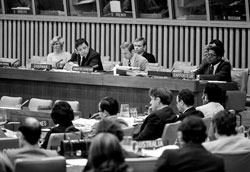 By resolution 2780 (XXVI) of 3 December 1971, the General Assembly requested the Commission to study as soon as possible the question of the protection and inviolability of diplomatic agents and other persons entitled to special protection under international law with a view to preparing a set of draft articles dealing with offences committed against such agents and persons, for submission to the Assembly at the earliest date that the Commission would consider appropriate. It also requested the Secretary-General to invite comments from Member States on the issue of the protection of diplomats and to transmit them to the Commission. By resolution 2780 (XXVI) of 3 December 1971, the General Assembly requested the Commission to study as soon as possible the question of the protection and inviolability of diplomatic agents and other persons entitled to special protection under international law with a view to preparing a set of draft articles dealing with offences committed against such agents and persons, for submission to the Assembly at the earliest date that the Commission would consider appropriate. It also requested the Secretary-General to invite comments from Member States on the issue of the protection of diplomats and to transmit them to the Commission.
At its twenty-fourth session, from 2 May to 7 July 1972, the Commission, after an initial general discussion, set up a working group to review the problem involved and to prepare a set of draft articles for submission to the Commission. At that session, the Commission had before it observations of Member States (A/CN.4/253 and Add.1-5), transmitted to the Commission in accordance with General Assembly resolution 2780 (XXVI), a working paper containing the text of a draft convention prepared by the delegation of Uruguay (A/C.6/L.822), and a working paper by a Member of the Commission (A/CN.4/L.182). This step, in contrast with the traditional procedure of appointing a Special Rapporteur to make a study of the subject and prepare draft articles, was based on the view of most of the members who participated in the general discussion that the subject was one of sufficient urgency and importance to justify the Commission adopting a more expeditious method of producing a set of draft articles for submission to the General Assembly at its twenty-seventh session.
At the conclusion of the initial stage of its work, the working group submitted to the Commission a first report (A/CN.4/L.186) containing a set of twelve draft articles on the prevention and punishment of crimes against diplomatic agents and other internationally protected persons. Following the Commission’s consideration of the draft articles, the working group revised them and referred them back to the Commission in two further reports (A/CN.4/L.188 and Add.1, and A/CN.4/L.189). The Commission considered those reports and provisionally adopted the set of twelve draft articles, which it submitted to the General Assembly as well as to Governments for comments.
The General Assembly, in resolution 2926 (XXVII) of 28 November 1972, decided to consider at its twenty-eighth session, in 1973, the draft convention on the prevention and punishment of crimes against diplomatic agents and other internationally protected persons with a view to the final elaboration of such a convention by the Assembly. It also invited States, specialized agencies and interested intergovernmental organizations to submit their written comments and observations on the draft articles prepared by the Commission.
At the twenty-eighth session of the General Assembly, in 1973, the provisions of the draft convention were referred to the Sixth Committee for consideration. During its discussion, the Sixth Committee had before it the draft articles on the prevention and punishment of crimes against diplomatic agents and other internationally protected persons which had been approved by the International Law Commission at its twenty-fourth (1972) session. Also before the Committee were comments submitted by Governments and various inter-governmental organizations, as well as the amendments to the International Law Commission's draft articles put forward in the Sixth Committee. The Committee considered the provisions of the draft convention in two stages: first, it considered all the draft articles, as well as the preamble and the final clauses, and (with the exception of article 9, which it decided to delete) referred them to a drafting committee, together with amendments submitted. Second, it considered and adopted, in their original form or in amended form, the texts of the draft articles recommended by the drafting committee. On 5 December 1973, the Sixth Committee adopted by consensus and recommended to the General Assembly the draft resolution and the annexed draft convention (A/9407).
On 14 December 1973, the General Assembly adopted the Convention on the Prevention and Punishment of Crimes against Internationally Protected Persons, including Diplomatic Agents, which was annexed to resolution 3166 (XXVIII). The Convention was opened for signature by all States at United Nations Headquarters in New York until 31 December 1974. It remains open for accession by any State. The Convention came into force on 20 February 1977.
Text of the Convention
Selected preparatory documents
(in chronological order)
Question of the protection and inviolability of diplomatic agents and other persons entitled to special protection under international law: Uruguay— working paper (A/C.6/L.822, 15 October 1971)
General Assembly resolution 2780 (XXVI) of 3 December 1971 (Report of the International Law Commission)
Working paper prepared by Mr. Richard D. Kearney, “Draft articles concerning crimes against persons entitled to special protection under international law” (A/CN.4/L.182, 28 February 1972, reproduced in Yearbook of the International Law Commission, 1972, vol. II)
Observations of Member States on the question of the protection and inviolability of diplomatic agents and other persons entitled to special protection under international law (A/CN.4/253, 11 April 1972 and Add.1-5, respectively of 3, 4, 17, 31 May 1972 and 16 June 1972, reproduced in Yearbook of the International Law Commission, 1972, vol. II)
Report of the Working Group on the question of the protection and inviolability of diplomatic agents and other persons entitled to special protection under international law: draft articles on the prevention and punishment of crimes against diplomatic agents and other internationally protected persons (A/CN.4/L.186, 16 June 1972)
Second report of the Working Group: Revised draft articles on the prevention and punishent of crimes against diplomatic agents and other internationally protected persons (A/CN.4/L.188 and Add.1, 30 June 1972, reproduced in Yearbook of the International Law Commission, 1972, Vol. II)
Third report of the Working Group: Revised article 2 (A/CN.4/L.189, 3 July 1972)
General Assembly, Verbatim records of meeting No. 2091 of 28 November 1972 (A/PV.2091).
General Assembly resolution 2926 (XXVII) of 28 November 1972 (Report of the International Law Commission)
Sixth Committee of the General Assembly, Summary records of meetings Nos. 1407-1413, 1416-1425, 1430-1437, 1439, 1445-1447, 1449-1451, 1455, 1457 and 1458 (A/C.6/SR. 1407, 1408, 1409, 1410, 1411, 1412, 1413, 1416, 1417, 1418, 1419, 1420, 1421, 1422, 1423, 1424, 1425, 1430, 1431, 1432, 1433, 1434, 1435, 1436, 1437, 1439, 1445, 1446, 1447, 1449, 1450, 1451, 1455, 1457 and 1458)
Report of the Sixth Committee (A/9407, 10 December 1973)
General Assembly, Verbatim Records of meeting No. 2202 of 14 December 1973 (A/PV.2202)
General Assembly resolution 3166 (XXVIII) of 14 December 1973 (Convention on the Prevention and Punishment of Crimes against Internationally Protected Persons, including Diplomatic Agents)
The Convention entered into force on 20 February 1977. For the current participation status of the Convention, as well as information and relevant texts of related treaty actions, such as reservations, declarations, objections, denunciations and notifications, see:
The Status of Multilateral Treaties Deposited with the Secretary-General
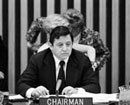 |
 |
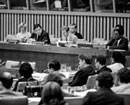 |
 |
16 October 1973
Twenty-eighth Session of the General Assembly, Meeting of the Sixth (Legal) Committee, United Nations Headquarters, New York. [Read more]
|
16 October 1973
Twenty-eighth Session of the General Assembly, Meeting of the Sixth (Legal) Committee, United Nations Headquarters, New York. [Read more] |
16 October 1973
Twenty-eighth Session of the General Assembly, Meeting of the Sixth (Legal) Committee, United Nations Headquarters, New York. [Read more] |
17 October 1973
Twenty-eighth Session of the General Assembly, Meeting of the Sixth (Legal) Committee, United Nations Headquarters, New York. [Read more] |
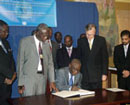 |
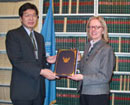 |
|
|
26 September 2003
Treaty Section, United Nations Headquarters, New York. [Read more] |
23 February 2007
Treaty Section, United Nations Headquarters, New York. [Read more] |
|
|
|
|